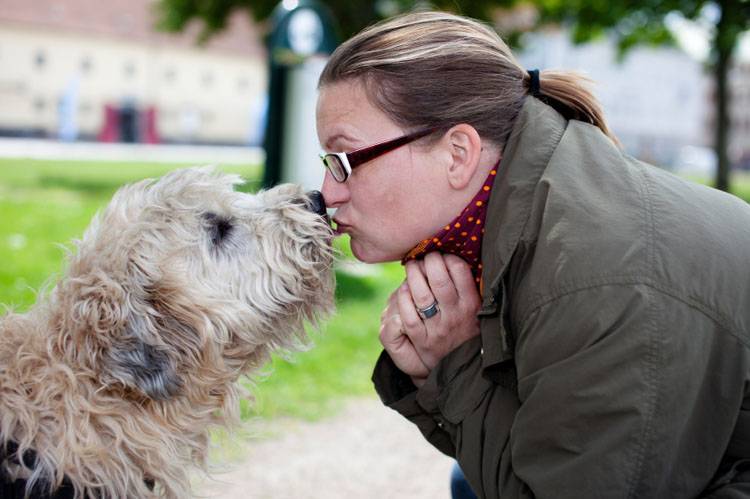Get Your Dog to Give Kisses on Cue
Who doesn’t love a big wet kiss from their dog? Okay, maybe there are a lot of you out there who would rather not receive a wet one, but maybe you know someone who loves receiving kisses from her dog. Well good news! You can train your dog to give kisses on cue, allowing you to clearly communicate to your dog when he is welcome to give kisses.
What You’ll Need
• Treats – I suggest using something that can easily slather onto your hand, such as peanut butter, cream cheese or a roll on treat.
• Training Location – Begin your dog training in a quiet, distraction-free area. This will help your dog learn quickly.
• Marker – Choosing a marker is very important, as this is what informs your dog he has made the right choice and performed the desired behavior. A marker or conditioned reinforcer is a word or sound that you’ve associated with a reward, such as “good” or” yes” or clicker.
How to Teach Your Dog to Give Kisses
Once you’re all set up in your training area, start with a hungry and calm dog. The reason I say to work with your dog while he’s hungry is because you want him to be motivated to work for the food reward. You also don’t want him to be full of energy, so he can focus better.
Step One
Put a small amount of your lure (peanut butter) in the palm of your hand or on the back of your hand, and then present your hand to your dog. Once your dog shows interest in the food, give your marker word “good” and provide your dog with a secondary treat from your pocket. Most dogs will give your hand a lick when they smell the yummy lure in your hand. If this is the case, you don’t need to provide a secondary reward; just give your marker word “good” and allow the lure to be his reward.
Practice this step in small sessions multiple times a day for the next couple of days. Once your dog becomes fluent with the lure, you can move onto the next step.
Step Two
Begin to fade the lure by only using a very small amount of peanut butter on your hand. Add the cue while your dog licks your hand (kisses) and mark the behavior with “good.” The key to fading the lure and adding the cue is to only use the food lure intermittently, meaning you don’t need to reapply the peanut butter right away if your dog licks the reward off the first time. You can reward with a less valuable reward like a Charlie Bear or soft dog treat. Once your dog does the behavior without or with little food, you can move to the next step.
Step Three
Now, you’re ready to begin training your dog to give kisses on cue. Continue to practice in the same place without distractions to facilitate success, present your un-baited hand and give your cue “kisses.” When your dog performs the behavior, give your marker word “good” followed by a high value reward! Once your dog is 90 percent compliant with performing the cue on command, begin fading the reward like we discussed above.
Enjoying Your Dog’s Kisses
Once your dog becomes fluent with this new behavior, you can really use it in any capacity you’d like: as a fun trick to show your guests, a normal greeting routine for you and your pup, a way to tell your dog you’ve had enough kisses or even a way to wake your family members up when they won’t get out of bed!
READ NEXT: How to Help Hand Shy Dogs





